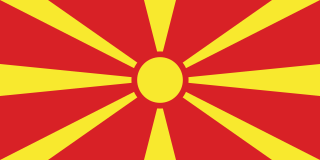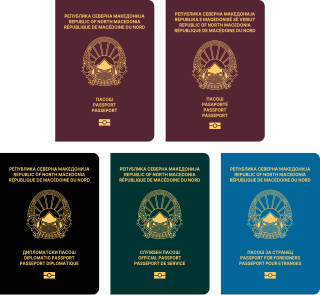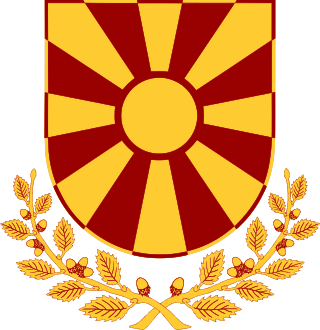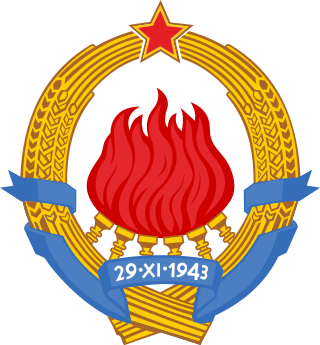
The foreign relations of North Macedonia since its independence in 1991 have been characterized by the country's efforts to gain membership in international organizations such as NATO and the European Union and to gain international recognition under its previous constitutional name, overshadowed by a long-standing, dead-locked dispute with neighboring Greece. Greek objections to the country's name had led to it being admitted to the United Nations and several other international fora only under the provisional designation Former Yugoslav Republic of Macedonia until its official and erga omnes renaming to North Macedonia, a name under which it is now universally recognised.

The flag of North Macedonia depicts a stylized yellow sun on a red field, with eight broadening rays extending from the center to the edge of the field. It was created by Miroslav Grčev and was adopted on 5 October 1995.

"Denes nad Makedonija" is the national anthem of North Macedonia. Todor Skalovski composed the music and Vlado Maleski wrote the lyrics of the song in the early 1940s. It was adopted as the national anthem in 1992, almost a year after the state's independence from Yugoslavia. Before its adoption as a national anthem, it was used as the regional anthem of the Socialist Republic of Macedonia, a constituent state of Yugoslavia, before it became the national anthem of the Republic of North Macedonia.

Macedonians are a nation and a South Slavic ethnic group native to the region of Macedonia in Southeast Europe. They speak Macedonian, a South Slavic language. The large majority of Macedonians identify as Eastern Orthodox Christians, who share a cultural and historical "Orthodox Byzantine–Slavic heritage" with their neighbours. About two-thirds of all ethnic Macedonians live in North Macedonia and there are also communities in a number of other countries.

The Socialist Republic of Macedonia, or SR Macedonia, commonly referred to as Socialist Macedonia, Yugoslav Macedonia or simply Macedonia, was one of the six constituent republics of the post-World War II Socialist Federal Republic of Yugoslavia, and a nation state of the Macedonians. After the transition of the political system to parliamentary democracy in 1990, the Republic changed its official name to Republic of Macedonia in 1991, and with the beginning of the breakup of Yugoslavia, it declared itself an independent country and held a referendum on 8 September 1991 on which a sovereign and independent state of Macedonia, with a right to enter into any alliance with sovereign states of Yugoslavia was approved.

The Football Federation of Macedonia – FFM ; Albanian: Federata e Futbollit të Maqedonisë, FFM) or Football Federation of North Macedonia is the governing body of football in North Macedonia, based in Skopje.

Sojuz na Izvidnici na Makedonija (The Scout Association of Macedonia) (Macedonian: Сојуз на извидници на Македонија), the national scouting organization of Republic of North Macedonia, became a member of the World Organization of the Scout Movement in 1997. The coeducational Sojuz na Izvidnici na Makedonija has 3010 members as of 2023.

The flag of Macedonia represents a Vergina Sun with 16 rays in the centre of a blue field. This flag, as well as the Vergina Sun, is commonly used as an unofficial symbol of the Greek region of Macedonia and its subdivisions. It is also used by organisations of the Greek Macedonian diaspora, such as the Pan-Macedonian Association chapters of the United States and Australia, as well as numerous commercial enterprises and private citizens.

North Macedonian passport are issued to citizens of North Macedonia for the purpose of international travel. Responsibility for their issuance lies with the Ministry of the Interior. The validity of the passport is 5 years for persons 4 to 27 years of age and 10 years for those 27 years of age and older. For children ages four and under, the validity of the passport is limited to two years. The passports conform to the recommended standards of the International Civil Aviation Organization (ICAO), and are biometric passports.

The following outline is provided as an overview of and topical guide to North Macedonia:

Miroslav Grčev is a Macedonian architect, graphic designer, comics artist and caricaturist. He is known for having designed the current flag of North Macedonia and a popular proposal for a new coat of arms of North Macedonia.

A representation of the sun is used as a heraldic charge. The most usual form, often called sun in splendour or in his glory, consists of a round disc with the features of a human face surrounded by twelve or sixteen rays alternating wavy and straight. The alternating straight and wavy rays are often said to represent the light and heat of the sun respectively.

The Vergina Sun, also known as the Star of Vergina, Vergina Star or Argead Star, is a rayed solar symbol first appearing in ancient Greek art of the period between the 6th and 2nd centuries BC. The Vergina Sun proper has sixteen triangular rays, while comparable symbols of the same period variously have sixteen, twelve, eight or (rarely) six rays.

The coat of arms of the President of the Republic of North Macedonia is the official coat of arms of the President of North Macedonia. It was adopted on 2 December 2009, designed by the Macedonian Heraldry Society earlier that year, having been registered by the society on 10 June.

The national emblem of North Macedonia depicts two curved garlands of sheaves of wheat, tobacco leaves and opium poppy fruits, tied by a ribbon decorated with embroidery of traditional Macedonian folk motifs. In the center of the ovoid frame are depicted a mountain, a lake and a sunrise. The features of the national coat of arms contain a rising sun which symbolizes freedom, the Šar Mountains with its peak named Ljuboten or Mount Korab and the river Vardar, with Lake Ohrid. The emblem also contains opium poppy fruits; this poppy was brought to the area during Ottoman times in the first half of the 19th century. Until 16 November 2009, the emblem also depicted a socialistic five-pointed star in the top. This emblem had been in use since 1946, shortly after the republic became part of Yugoslavia.

The Emblem of Yugoslavia featured six torches, surrounded by wheat with a red star at its top, and burning together in one flame; this represented the brotherhood and unity of the six federal republics forming Yugoslavia: Bosnia and Herzegovina, Croatia, Macedonia, Montenegro, Serbia and Slovenia. The date imprinted was 29 November 1943, the day the Anti-Fascist Council for the National Liberation of Yugoslavia (AVNOJ) met in Jajce on its second meeting and formed the basis for post-war organisation of the country, establishing a federal republic. This day was celebrated as Republic Day after the establishment of the republic. The emblem of Yugoslavia, along with those of its constituent republics, are an example of socialist heraldry.

The flag of Skopje is a red vertical banner in proportions 1:2 with the coat of arms of the city in golden-yellow placed in its left upper quarter. The coat of arms has the form of a shield and on it are pictured: the Stone Bridge with the Vardar River, the fortress Kale and the snowy peaks of a mountain.

The Museum of the Republic ofMacedonia, formerly and still unofficially known as the Museum of Macedonia, is a national institution in Macedonia and one of the oldest museums in the country. It is located in the Old Bazaar in Skopje, near the Skopje Fortress. The Museum of the Republic of Macedonia was created by joining three museums in one. The three museums that were unified were the archaeological, historical and ethnological museum, of which the archaeological museum was the oldest one; it was opened in 1924 and that date is considered as an establishing date of the national museum. During the existence of the Socialist Republic of Macedonia, the museum was known as People's Museum of Macedonia.
Communist symbolism represents a variety of themes, including revolution, the proletariat, the peasantry, agriculture, or international solidarity. The red flag, the hammer and sickle and the red star or variations thereof are some of the symbols adopted by communist movements, governments, and parties worldwide.

















